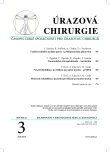TRAUMATICKÁ ASTRAGALEKTÓMIA – kazuistika
TRAUMATICKÁ ASTRAGALEKTÓMIA – kazuistika
The authors refer to a rare traumatic astragalectomy performed on a 26-year-old motorcyclist who had crashed into a field. A severe open wound and contaminated devastation of the ankle and leg required acute surgical revision, where it was determined that the entire astragalus (talus bone) had been lost. Given the serious nature of the high-energy open wound, endangering foot vitality, and after having thoroughly revised and debrided devitalized soft tissue, crural-calcaneal osteosynthesis was done with an external fixator during Period I. When the soft tissue had healed, a crural-calcaneal spongioplasty was performed over ten months during Period II for the purpose of arthrodesis, using three screws through the calcaneus and tibia. After a further year, Period III saw osteosynthetic material removed while exercise and rehabilitation continued. Five years after the accident the patient was walking without a cane and with minimal limping. In general, the authors didactically suggest an astragalectomy broken down according to cause: 1. Non-traumatic - severe foot and ankle deformities and post-infections (e.g., past history of tuberculosis); 2. Post-traumatic – only rarely mentioned in the literature and covering comminuted and dislocated fractures of the talus bone. 3. Traumatic - when an accident causes either discontinuity of the talus bone with its original location or full loss.
Key words:
Astragalectomy, open talus dislocation.
Autoři:
Jaroslav Cigaňák; Tomáš Cigaňák; Dušan Magdin; Vladimír Gaman
Působiště autorů:
Department of Trauma and Orthopedic Surgery, Hospital Bojnice, Slovakia
; Traumatologicko-ortopedické oddelenie, Nemocnica v Bojniciach
Vyšlo v časopise:
Úraz chir. 22., 2014, č.3
Souhrn
The authors refer to a rare traumatic astragalectomy performed on a 26-year-old motorcyclist who had crashed into a field. A severe open wound and contaminated devastation of the ankle and leg required acute surgical revision, where it was determined that the entire astragalus (talus bone) had been lost. Given the serious nature of the high-energy open wound, endangering foot vitality, and after having thoroughly revised and debrided devitalized soft tissue, crural-calcaneal osteosynthesis was done with an external fixator during Period I. When the soft tissue had healed, a crural-calcaneal spongioplasty was performed over ten months during Period II for the purpose of arthrodesis, using three screws through the calcaneus and tibia. After a further year, Period III saw osteosynthetic material removed while exercise and rehabilitation continued. Five years after the accident the patient was walking without a cane and with minimal limping. In general, the authors didactically suggest an astragalectomy broken down according to cause: 1. Non-traumatic - severe foot and ankle deformities and post-infections (e.g., past history of tuberculosis); 2. Post-traumatic – only rarely mentioned in the literature and covering comminuted and dislocated fractures of the talus bone. 3. Traumatic - when an accident causes either discontinuity of the talus bone with its original location or full loss.
Key words:
Astragalectomy, open talus dislocation.
Zdroje
1. ASSAL, M., STERN, R. Total extrusion of the talus: a case report. J Bone Joint Surg Am. 2004, 86, 2726–2731.
2. BURSTON, JL., ISENEGER, P., ZELLWEGER R. Open total talus dislocation: clinical and functional outcomes: a case series. J Trauma. 2010, 68, 1453–1458.
3. CARMACK, JC., HALLOCK, H. Tibiotarsal artrodesis after astragalectomy. A report of eight cases. J Bone Joint Surg Am. 1947, 29, 476–482.
4. DUNGL, P. Ortopedie a traumatologie nohy (Orthopaedics and Leg Traumatology). Prague: Avicenum, 1989, 288 p.
5. DUNGL, P. et al. Noha. (the Leg), p. 1071-1194 in Ortopedie (Orthopaedics), Prague: GRADA Publishing, a.s. 2005, 1280 p.
6. ELY, LW. Astragalectomy for tuberculosis of the tarsus. Cal State J Med. 1925, 13, 286.
7. GRAHAM, WT., FAULKNER, DM. Astragalectomy for fractures of the astragalus. Ann Surg. 1929, 89, 435–438.
8. GULAN, G., SESTAN, B., JOTANOVIC, Z. et al. Open total talar dislocation with extrusion (missing talus). Collegium Antropologicum. 2009, 33, p. 669.
9. HIRAIZUMI, Y., HARA, T., TAKAHASHI, M. et al. Open total dislocation of the talus with extrusion (missing talus): report of two cases. Foot ankle. 1992, 13, 473–477.
10. KRASIN, E., GOLDWIRTH, M., OTREMSKI, I. Complete open dislocation of the talus. J Accid Emerg Med. 2000, 17, 53–54.
11. KUBÁT, R. Ortopédie dětského věku (Paediatric Orthopaedics). Prague: Avicenum, 1982, 317 s.
12. MACAUSLAND, WR., MACAUSLAND, AR. Astragalectomy (the Whitman operation) in paralytic deformities of the foot. Ann Surg. 1924, 80, 861–880.
13. NEWCOMB, WJ., BRAV, E A. Complete dislocations of the talus. J Bone Joint Surg Am. 1948, 30, 872–874.
14. SHARIFI, SR., EBRAHIMZADEH, MH., AHMADZADEH-CHABOK, H. et al. Closed total talus dislocation without fracture: a case report. Cases Journal. 2009, 2, 9132.
15. THOMPSON, TC. Astragalectomy a treatment of calcaneovarus. J Bone Joint Surg Am. 1939, 21, 627–647.
16. TYPOVSKÝ, K. et al. Traumatológia pohybového ústrojí (Traumatology of the locomotor system). Vol. 2. Prague: Grada Avicenum,1972. 504 p.
17. WHITMAN, A. Astragalectomy and backward displacement of the foot. An investigation of its practical results. J Bone Joint Surg Am. 1922, 4, 266–278.
18. XARCHAS, KC., PSILLAKIS, IG., KAZAKOS, K, J. et al. Total Dislocation of the Talus without a Fracture. Open or Closed Treatment? Report of Two Cases and Review of the Literature. Orthopaedics. 2009, 3, 52–55.
19. YOUNG, AB. Club foot treated by astragalectomy. The Lancet. 1962, 29, 670–671.
Štítky
Chirurgia všeobecná Traumatológia Urgentná medicínaČlánok vyšiel v časopise
Úrazová chirurgie

2014 Číslo 3
- Metamizol jako analgetikum první volby: kdy, pro koho, jak a proč?
- Kombinace metamizol/paracetamol v léčbě pooperační bolesti u zákroků v rámci jednodenní chirurgie
- Kombinace kodein/paracetamol prokázala stejný analgetický účinek jako hydrokodon/paracetamol
- 100 let s metamizolem: jaké je jeho současné postavení v léčbě bolesti
- Fixní kombinace paracetamol/kodein nabízí synergické analgetické účinky
Najčítanejšie v tomto čísle
- NEUROREHABILITACE PO TĚŽKÉM PORANĚNÍ MOZKU – PŘEHLED
- MOŽNOSTI REHABILITACE PACIENTŮ PO TĚŽKÉM PORANĚNÍ MOZKU
- TRAUMATICKÁ ASTRAGALEKTÓMIA – kazuistika
- Přečetli jsme za vás
